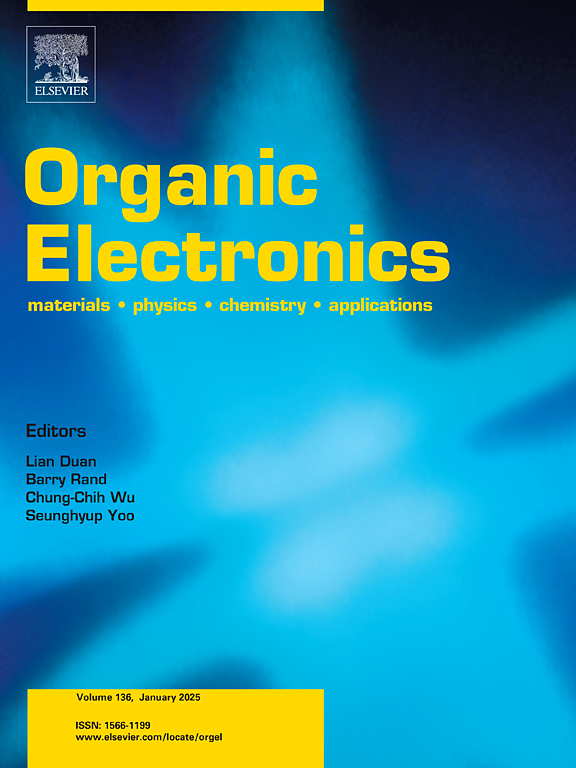Evidence for localized trap formation during TADF OLED degradation
IF 2.6
4区 工程技术
Q3 MATERIALS SCIENCE, MULTIDISCIPLINARY
引用次数: 0
Abstract
Thermally activated delayed fluorescence (TADF) emitters attract interest as organic light-emitting diode (OLED) materials with potentially 100 % internal quantum efficiency (IQE). Their application in commercial displays is still hindered due to the not yet sufficient operational stability. We analyze the degradation mechanism in a TADF OLED by combining intermittent electro-optical characterization with device simulations. Evidence for the generation of trap states is found in capacitance-voltage (C-V) measurements. To explain both the C-V as well as the current-voltage and the capacitance-frequency evolution during prolonged operation times, at least two types of trap states are necessary. Device simulations are used to assess their location within the multilayer structure. It is found that both hole and electron traps at the HTL/EML interface can explain the experimental data. A quantitative comparison of simulations and experimental data reveal a hole and electron trap density of 8 ∙ 1018 cm−3 and 8 ∙ 1017 cm−3, respectively, at LT80 (the time at which the luminance has dropped to 80 % of its initial value). The main driver for the current efficiency decrease are the hole traps inside the HTL. The findings unravel the weak points in the TADF OLED and thereby guide further development to enhance device stability.

在TADF OLED降解过程中局部陷阱形成的证据
热激活延迟荧光(TADF)发射器作为具有潜在100%内量子效率(IQE)的有机发光二极管(OLED)材料引起了人们的兴趣。它们在商业显示器中的应用仍然受到阻碍,因为还没有足够的操作稳定性。本文采用间歇电光特性与器件仿真相结合的方法分析了TADF OLED的退化机理。在电容-电压(C-V)测量中发现了产生陷阱状态的证据。为了解释在长时间工作期间C-V以及电流-电压和电容-频率的演变,至少需要两种类型的陷阱状态。器件模拟用于评估它们在多层结构中的位置。发现HTL/EML界面上的空穴和电子陷阱都能解释实验数据。模拟和实验数据的定量比较表明,在LT80(亮度下降到初始值的80%)时,空穴和电子陷阱密度分别为8∙1018 cm - 3和8∙1017 cm - 3。当前效率降低的主要驱动因素是html内部的空穴陷阱。这些发现揭示了TADF OLED的弱点,从而指导了进一步的开发,以提高器件的稳定性。
本文章由计算机程序翻译,如有差异,请以英文原文为准。
求助全文
约1分钟内获得全文
求助全文
来源期刊

Organic Electronics
工程技术-材料科学:综合
CiteScore
6.60
自引率
6.20%
发文量
238
审稿时长
44 days
期刊介绍:
Organic Electronics is a journal whose primary interdisciplinary focus is on materials and phenomena related to organic devices such as light emitting diodes, thin film transistors, photovoltaic cells, sensors, memories, etc.
Papers suitable for publication in this journal cover such topics as photoconductive and electronic properties of organic materials, thin film structures and characterization in the context of organic devices, charge and exciton transport, organic electronic and optoelectronic devices.
 求助内容:
求助内容: 应助结果提醒方式:
应助结果提醒方式:


